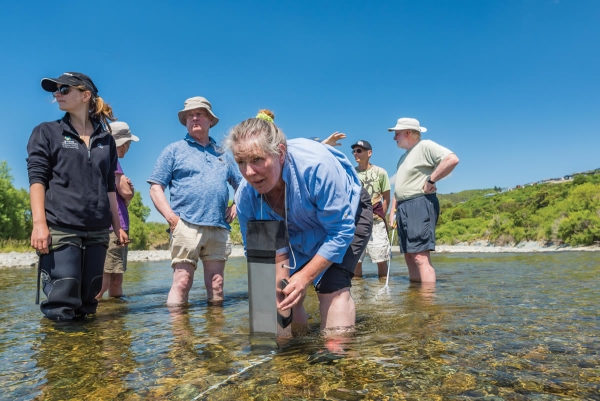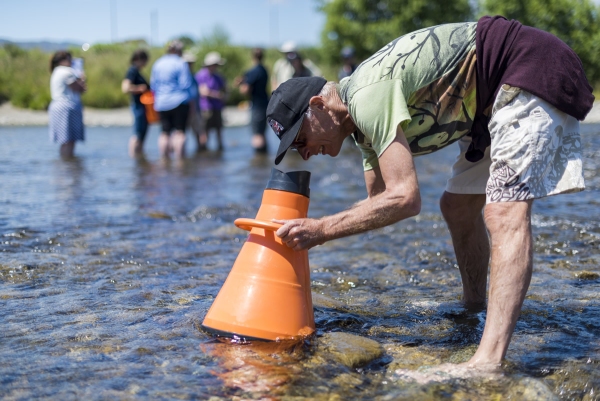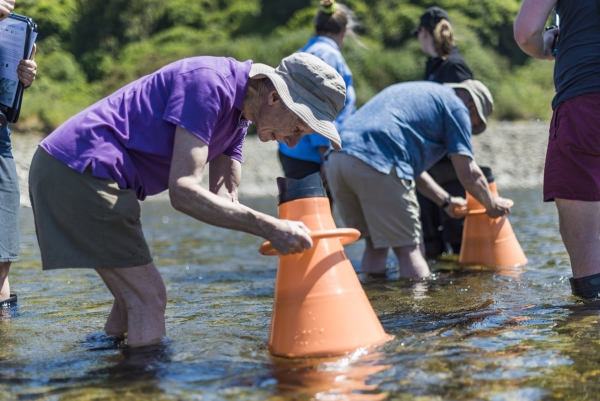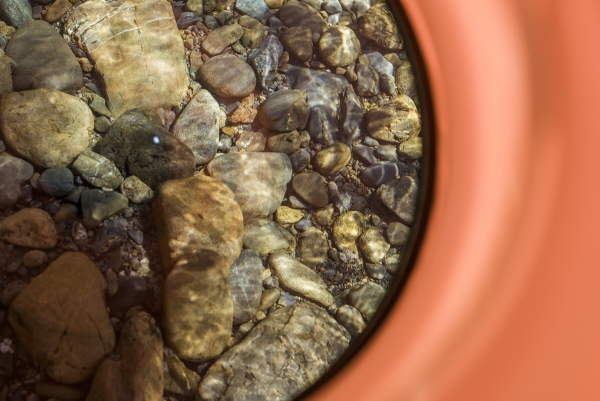A group of volunteers who love the Hutt River are helping to care for it over summer.
At the bottom of the cone is clear plastic giving her a crisp, close-up view of a rock on the river bed as she estimates how much of it is covered by toxic algae.
She is one of a small group of citizen scientists who will wade into the river every Monday around noon for the next few months to look at rocks, measure water temperature and visual clarity, collect a water sample for E. coli testing and count the amount of rubbish.
“I’m a long-term resident and I really care what happens to the river. I want to know I can swim in it and walk my dog alongside it.”
That’s an issue – 12 dogs have died since 2005 after coming into contact with mats of Phormidium, a type of cyanobacteria which has been prevalent in the Hutt River in some years and is potentially toxic. Phormidium can grow quickly over summer spreading over rocks and then peeling off to float in poisonous clumps at the river’s edge where dogs love to play.
Swimming in the Hutt is something Pat van Berkel has done for decades. He’s one of the founders of Friends of the Hutt River, a community advocacy group seeking to improve the health of the river.
“I swam here last night, I’ll probably swim here tonight. It’s just a great pleasure but the cyanobacteria are a real problem and likely to get worse as urban areas expand.”
Others in the group coordinated by Allan Sheppard, are also members of Forest and Bird and the Silverstream Care Group or simply concerned locals.
NIWA freshwater ecologist Dr Amanda Valois regards them as being at the front line of assessing the health of the river.
“The local community is always the first to figure out when something is going wrong with their waterway and I think it’s our obligation as scientists to take them seriously.”
At the beginning of summer, supported by GWRC environmental monitoring staff, Dr Valois shows the group how to take the measurements, helping them set up the equipment and encouraging them as they grapple with unfamiliar equipment.
She has a particular interest in citizen science and wants to support people to determine if waterways are healthy enough to swim in. Over the past few months defining “swimmability” has proved difficult. But Dr Valois is determined to make it easier to understand.
“Scientists measure bacteria or periphyton to determine swimmability. But when I go swimming I look at how much rubbish is around, whether the water is dirty or brown or the flow is low. For me a swimmable river is clear and fast flowing. For others there may be different values.”
The Hutt River citizen scientists collect their data alongside a GWRC environmental monitoring officer who makes separate recordings. The two sets of information will be compared at the end of summer.
NIWA is confident the volunteers can collect reliable data that will enable them to independently assess the suitability of rivers for contact recreation. (A recent GWRC survey showed one million people visit the Hutt River annually.) And because regional councils can’t monitor every waterway, it is hoped this project will empower other groups to follow suit.
Beth is hopeful of learning enough skills to monitor the Belmont Stream, a tributary of the Hutt River, near her house.
“There are a couple of water holes that are used in summer but they are not tested and there are cows in the upper catchment. I want to learn what’s happening and I want everyone to care about their own waterways around the country.”
Managing fresh water for recreational use is now mandatory. The National Policy Statement for Freshwater Management was amended in August this year to include a target that 90 per cent of New Zealand’s rivers are swimmable by 2040.
Pat van Berkel is hopeful generations long beyond that will be swimming in the Hutt River.
“If people don’t step up, then programmes like this don’t happen. I want future generations to enjoy the river just as much as I have enjoyed it. I think New Zealanders have a passion for the outdoors and in a river you go underwater, swim and play – it’s just an amazing place to be.”
If you are interested in joining a citizen science group see: Nature Space or get in touch with your local council.




